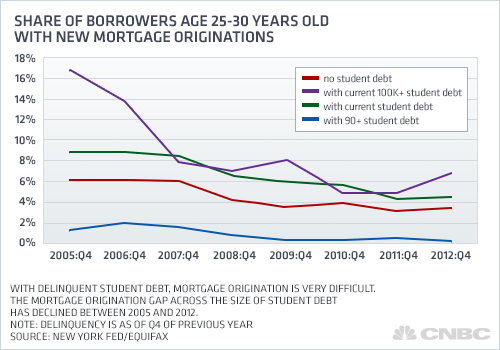April 16, 2013
ALEX CARRICK
Chief Economist, CanaData
U.S. new home starts in February were 917,000 units, seasonally adjusted and annualized (SAAR), according to a joint press release from the Census Bureau and the Department of Housing and Urban Development.
The monthly level of housing starts has been above 900,000 units for three months in a row. Within that period, their monthly high was 982,000 units reached in December of last year.
On a month-to-month basis, February 2013’s level was almost even with January 2013 at +0.8%, but it was a much more impressive +28% when compared with February of last year.
Additionally, the latest building permits figure — which is a leading indicator, by a month or two, for starts — was quite encouraging. The number of residential permits issued in February was 946,000 units SAAR, an increase of 5% versus January and an uptick of 34% when compared with February 2012.
It’s possible the importance of housing’s recovery to the overall U.S. economy is being underestimated. Gross domestic product (GDP) projections for 2013 mostly lie between +2.0% and +2.5%, after a +2.2% performance in 2012.
An upward creep in taxes, higher medical costs for employers, plus jobs cuts and furloughs in the public sector are being blamed for keeping growth lower than it might otherwise be. Still, there are some forecasters who think +3.0% is attainable and the main reason will be better residential construction. The ripple effects (i.e., “multipliers” and “accelerators” in economic jargon) of a stronger homebuilding sector are enormous.
There are no guarantees, but this argument may have validity. Consider that the current recovery in housing starts will have a magnitude never seen before in the U.S. economy.
A look at historical data from the Census Bureau is revealing. Going back to 1959, when the statistical series begins, there has never been another period of decline nearly as steep as between January 2006 and April 2009. Within that interval, starts plunged 80% from a pre-recession peak of 2.273 million units SAAR to a bottom of only 478,000 units.
Only bungee jumpers had ever experienced that kind of descent before and lived to tell about it.
Economic events are often governed by a pendulum that swings back and forth to establish equilibrium. Sometimes, the duration of the movement in one direction or another can be a long time coming. A perfect example is the recovery in NASDAQ stock prices since the dot.com collapse. They still haven’t returned to their prior peak. But they are finally showing that such an eventuality isn’t totally out of the question.
U.S. home starts don’t have to make it all the way back to 2.3 million units to have a huge impact. Their average level of 940,000 units in the three most recent months is nearly double the volume to which they sank in the trough. Even if they only return to the lower end of a “normal” range of 1.5 million to 1.7 million units — which some forecasters are saying will happen by the end of next year — they will have more than tripled since their most recent low.
In the U.S., there have traditionally been two sub-sectors with exceptional influences on the overall economy — automotive demand and residential construction. Bringing the analysis up to date, those two might now be augmented by a third major player, the high-tech sector.
In Canada, where the economy is smaller and therefore more factors can assume larger roles in the overall results, the number of sub-sectors that can create an out-sized influence may be a little larger — auto production, energy exports, residential construction and start-ups or completions of mega projects in non-residential construction.
Economics 101 provides the following advice on how to move an economy out of a recession. Step number one, cut interest rates in order to stimulate the housing sector. It’s taken a long time south of the border, but the standard framework for recovery is finally taking hold.
And what a recovery it might be. Simply consider all the side effects of stronger housing starts. Remember in what follows, that improved activity levels reap a harvest of greater profits and more employment.
Suppliers of building products will realize a pick-up in sales. The Home Depots, Reno-Depots and Lowe’s of this world and their close cousins will benefit.
Further back in the supply chain are sawmills and cement manufacturers. Softwood lumber producers are already seeing prices for their output that have escalated dramatically.
The railroad and trucking industries move building products to wholesalers, retailers and other customers.
New homes have to be heated and cooled, bringing in the energy utilities.
Governments will receive more property taxes from new subdivisions.
Lawyers, real estate agents and mortgage brokers will smile more.
Let’s not forget the banking community. Sales of more new homes will mean greater mortgage business, contributing to better earnings. (In Canada, a decline in new home starts is expected to eat into banking sector profits this year.)
Stronger housing starts will also mean more retail sales by storekeepers who supply furniture, appliances, television sets, stereos, lighting fixtures, plumbing supplies, cabinetry, carpeting, drapes, blinds, dishes, silverware, paintings, paint and the list goes on and on.
The better housing sector alone will be a big boon to the U.S. economy. But it’s not just housing that’s picking up smartly south of the border.
Earlier, I mentioned some other pillars of the U.S. economy. Autos sales have improved nicely. Many high-tech firms are experiencing a renascence as evidenced by the surge in NASDAQ equity prices. There is an energy boom underway in a number of states. And an unprecedented amount of money has been made available by the Federal Reserve.
The politicians give the impression they’re still trying to gum up the works. But there is a great deal of underlying strength in the economy that will continue to march forward, with new home starts riding point.
Wouldn’t it be lovely — and a refreshing change — if whatever happens in Washington turns out to be irrelevant?




© 2013 The Peral Group